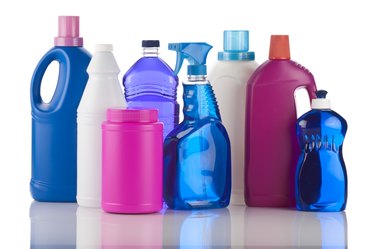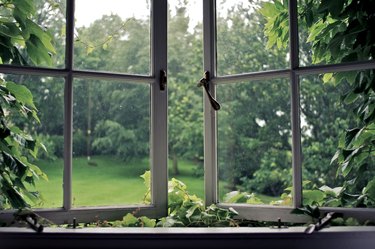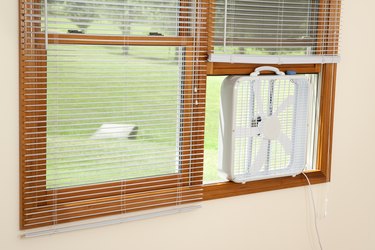Homes are a lot more energy-efficient than they used to be, and that's partly because we've gotten a lot better at making them airtight. That's a good thing, but it also means that indoor air quality has become a very real concern. We spend a lot of time in our living spaces (that's what they're for!), and the air inside is often worse than the air outside. Here are a few of our favorite hacks to help you fight back and breathe easier in your personal space.

Video of the Day
1. Say Goodbye to Chemical Air Fresheners
One of the cruel ironies of indoor air quality is that sometimes, it's the very products we choose to improve the air that cause the damage. Most of the "air fresheners" you'll find at the supermarket or drugstore do nothing to improve the air. Instead, they simply mask underlying odors through the use of powerful (and usually chemical-based) scents. Spray deodorizers add propellants to the mix as well. If you want pleasant aromas in your house, a few drops of essential oil or an oil diffuser is a more natural option.
 Instead of sprays or chemical-based air fresheners, use essential oils. Image Credit: Catherine Falls Commercial/Moment/GettyImages
Instead of sprays or chemical-based air fresheners, use essential oils. Image Credit: Catherine Falls Commercial/Moment/GettyImages
2. Lose the Harsh Cleaning Products
Keeping things clean (and especially preventing mold and removing it quickly when it appears) is the best way to tackle air-quality issues at their source. Unfortunately, sometimes the cleaning products themselves are responsible for heavy fumes and lingering chemical buildup that can affect your indoor air quality. You may or may not be especially sensitive to them, but you're not doing your lungs any favors. Instead of commercial products, try natural DIY cleaning solutions made with everyday ingredients like lemon, vinegar and baking soda, or if you really love pleasant scents, use essential oils.
 You can replace many cleaning products with air-friendly natural alternatives. Image Credit: fcafotodigital/E+/GettyImages
You can replace many cleaning products with air-friendly natural alternatives. Image Credit: fcafotodigital/E+/GettyImages
3. Open a Window
Sometimes, the easiest answer is the best. If you want your indoor air to be fresh and pure, why not just open a window and let in some fresh, pure outside air? Obviously, there are limitations to this approach. It assumes your outside air is clean and fresh and that it's not too cold to have a window open, but when it works, it works well. If you want the same benefits without actually leaving a window open, you can install frame-mounted "trickle vents" over your existing windows or upgrade to windows that include a vent the next time you do some work on your home.
 Opening a window is a quick and easy way to improve the indoor air. Image Credit: ©andyjbarrow/Moment/GettyImages
Opening a window is a quick and easy way to improve the indoor air. Image Credit: ©andyjbarrow/Moment/GettyImages
4. The Box Fan Hack
If you'd love to have your window open but the outside air isn't necessarily of the best quality, you can improvise an air purifier for your window using an ordinary box fan. Choose a square 20 x 20-inch box fan and tape a high-quality 20 x 20-inch furnace filter to the intake side of the fan, taking good care to seal it all the way around. Put it in your window and seal the space around the fan with some combination of cardboard, plastic, tape or whatever else works for you. Leave the fan on low or medium (it will burn out quickly on high) and enjoy filtered air where you need it.
 Adding a furnace filter to a box fan purifies the outside air as it enters your home. Image Credit: DonNichols/E+/GettyImages
Adding a furnace filter to a box fan purifies the outside air as it enters your home. Image Credit: DonNichols/E+/GettyImages
5. Tame Your Candle Habit
There's something deeply satisfying about a bit of open flame, whether it's an outdoor campfire, an indoor fireplace or a simple candle. If candles are your favorite way to create indoor ambiance, you may not be doing your air quality any favors. Most candles are made with paraffin, a petroleum product, and while they burn relatively cleanly, they also bring some unpleasant hydrocarbons to your inside air (and lungs). Indulging less is one option, or better yet, you can switch to beeswax. Not only is it clean but it will generate negative ions that help actively clean your air.
 If you can’t do without your candles, switch to beeswax. Image Credit: wakila/E+/GettyImages
If you can’t do without your candles, switch to beeswax. Image Credit: wakila/E+/GettyImages
6. Cook With High-Temperature Oils
Your kitchen is another source of impurities in the air. Not only can misplaced or overlooked food breed foul-smelling mold and bacteria but the actual oil with which you cook can be a significant culprit. All oils have a point at which they begin to smoke and break down – called, logically enough, the smoke point – and even after you've quieted the smoke alarm, those sooty particles will hang in the air for a long time. Avoid them entirely by using oils that can handle the heat. Canola and safflower oil are great for ordinary frying, while grapeseed oil and avocado oil will handle extra-high temperatures.
 Make sure your oil’s smoke point is suitable for high temperature use. Image Credit: © Santiago Urquijo/Moment Open/GettyImages
Make sure your oil’s smoke point is suitable for high temperature use. Image Credit: © Santiago Urquijo/Moment Open/GettyImages
7. Clean Your Exhaust Vents
Your kitchen and bath are important battlegrounds in the struggle for pure air, partly because they're sources of unpleasant smells and partly because they both generate lots of mold-inducing moisture. The cure for both is an efficient exhaust fan, and your fan can only work well when it's clean. Make a practice of cleaning both fans every month or two (your kitchen fan especially) and if necessary, pick a regular date and mark it on your calendar. If your fan can't keep up even when clean, start budgeting for an upgrade.
 Cleaning your vents helps them work efficiently. Image Credit: Sisoje/E+/GettyImages
Cleaning your vents helps them work efficiently. Image Credit: Sisoje/E+/GettyImages
8. Keep Your Pets Well Groomed
As much as we love our fur babies, it has to be said that they don't do our indoor air any favors. Shedding and dander are issues with either cats or dogs, and with cats, you also have the dust (and smells) from the litter box with which to contend. Maintenance is your friend when pets are concerned. Keep them well groomed, well brushed and well bathed to keep shedding and dander to a minimum. For cats, who don't take to bathing as a rule, you can use a brush-through dry shampoo. Investing in a covered litter box and dust-free kitty litter can help as well.
 Pet dander is a common air-quality problem. Image Credit: mixetto/E+/GettyImages
Pet dander is a common air-quality problem. Image Credit: mixetto/E+/GettyImages
9. Clean Those Carpets. A Lot.
Carpets are comfy on the feet, especially on cold mornings when tile or wood make you long for a pair of fluffy slippers. Unfortunately, they're also a magnet and trap for all kinds of odors, spores and particulates, like dust, soot and dander. Basically, carpet is one giant dirty sock that can't get tossed in the washing machine. For the best indoor air, you'll need to clean them pretty frequently. Rent a machine or have them cleaned professionally when your budget permits and in between, keep them clean with store-bought or DIY cleaning products.
 Keeping your carpets clean can help a lot with air quality. Image Credit: pinstock/E+/GettyImages
Keeping your carpets clean can help a lot with air quality. Image Credit: pinstock/E+/GettyImages
10. Be a Smart Shopper
The most fundamental pure air hack of all is to not bring pollutants into your home when it can be avoided. For example, paints, solvents, varnishes and many other household products contain volatile organic compounds (VOCs), which the United States Environmental Protection Agency considers indoor pollutants. Most of these products are now available in low-VOC or no-VOC formulas, so look for those whenever you're shopping. Other purchases, such as carpets, upholstered furniture and even freshly dry-cleaned clothes, can also emit VOCs when they first arrive at your home, so consider leaving them in the garage or another well-ventilated space for a few days before you bring them inside.
 Keep your air pure by shopping for low-VOC products whenever possible. Image Credit: kutaytanir/E+/GettyImages
Keep your air pure by shopping for low-VOC products whenever possible. Image Credit: kutaytanir/E+/GettyImages







































